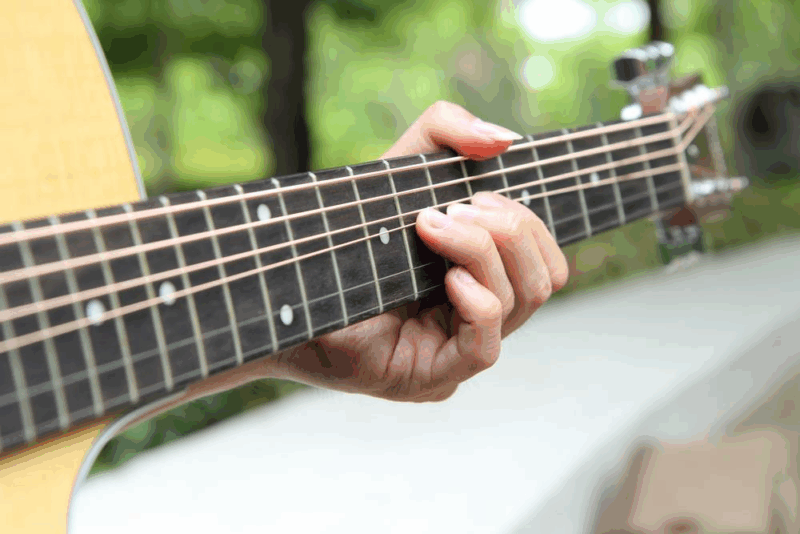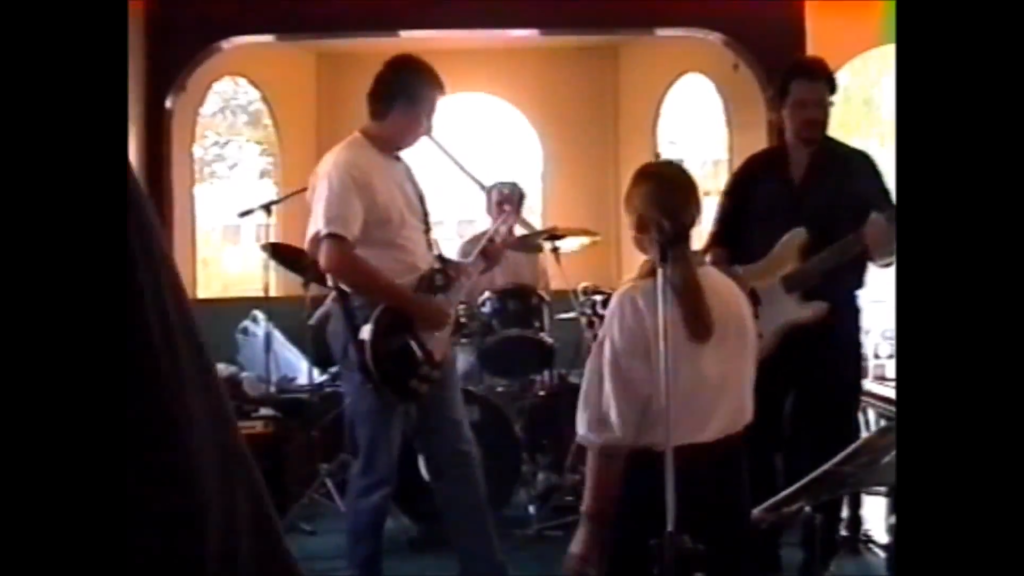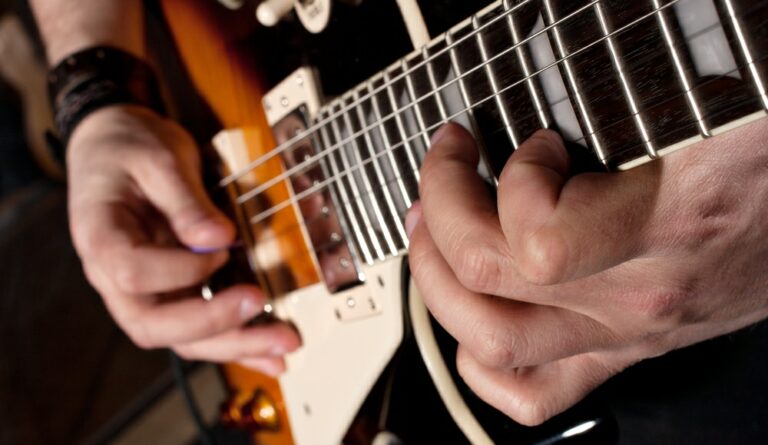How to Transition from Chords to Your First Guitar Solo.
Intro – A Personal Journey.

Learning how to transition from chords to your first guitar solo isn’t as big a step as you might think. In fact, much of what you already know your sense of rhythm, timing, and chord knowledge forms the backbone of your lead playing. All you need is the right approach to connect your rhythm skills to your first simple solos.
Where to Start?
Playing your fist solo is all about being able to sing it! Yes, if you can hum the solo then you will remember it and know where to go next. This may seem odd at first, but if you can hum the rhythm and timing of it then your representation will be accurate to the original.
I’m a Slash fan from the 80’s and always dreamed of playing the Sweet Child of Mine lead parts. In this song there are two short fills that could be called minor solos that link to the main riff we all know and love! It took me a while but eventually I could play all the fill/solos and the main lead solo to a reasonable representation. No! I’m not Slash!

I sit here as I type this and hum the solo from beginning to end! I’ve been doing it unconsciously I noticed. This is a real bonus if you can otherwise you tend to just remember the notes and not the slow/rhythm of the parts you wish to emulate.
Understanding the Pentatonic Foundation.
Most guitarists begin soloing with the Minor Pentatonic scale, one of the easiest and most versatile scales to play. The word “pentatonic” comes from “penta,” meaning five because it’s a five-note scale. These five notes sound great over many styles, especially blues and rock, and avoid clashing with common chord tones.
You’ve likely seen this scale broken into five positions or “boxes” across the fretboard. Each box connects seamlessly, allowing you to travel up and down the neck as you grow more confident.
Let’s take A Minor Pentatonic as our example.
🎵 A Minor Pentatonic Scale (Box 1 – Root on 5th Fret).
e|---------------------------5-8-
B|-----------------------5-8-----
G|-------------------5-7---------
D|---------------5-7-------------
A|-----------5-7-----------------
E|-------5-8---------------------
Notes in A Minor Pentatonic:
A – C – D – E – G
💡 Tip: Practice the pattern slowly using alternate picking (down-up strokes). Once it’s smooth, try connecting it to Box 2 by sliding up to the 8th fret position.
The Scale is Moveable! Oh Yes it is!
Here’s a secret to automatically double your knowledge of the Minor Pentatonic Scale! The Minor pentatonic scale is a SAD SCALE, that is its sort of melancholy in sound quality. It fits with specific minor chords more but can be used over the major ones in the scale.
There is also a A Major Pentatonic Scale! Yes, and all you need to do to move from MINOR to MAJOR pentatonic scale is slide back three frets! Yes its that dam simple!
So your wailing away in Am Pentatonic scale on the 5th fret and you think, Mumm I want to change this up a bit! Well You can simply slide back to the 3rd fret at G and continue whaling for a bit then head back to the 5th fret. Nice eh!

So if your playing minor pentatonic and want to add a section of more uplifting notes then slide back to G is the way to achieve this. Rock on!
Its not uncommon to move from minor to major and back. It will sound better if you do it over the major chords in the scale is true but works well anytime.
Here’s a list of the diatonic chords in the A minor (natural minor) scale:
- Am (A minor)
- Bdim (B diminished)
- C (C major)
- Dm (D minor)
- Em (E minor)
- F (F major)
- G (G major)
Even More 1st Position Tricks for Beginners!
Now you may have noticed your guitar has more frets than just the 12 your initially playing on. True, yes? Note the DOUBLE DOTS on the 12th fret on all guitars! Well from the nut of the guitar you have the first octave but and here’s the kicker, you have a nearly full higher octave that starts from these double dots!
Depends on frets on your guitar! Many have 21 or 22 frets (Gibson/Fender) but some have a full 24 (Jackson & More) so its two full scale lengths long.

Take your Am Pentatonic scale up to the 17th Fret and your at the Next Position in Am! Oh hell yeah! You may have started at the fifth fret and even dropped into Major for a section but now its time to blow the roof off your playing. Screaming high notes are now waiting for you up the other end of the fretboard! That’s really cool eh!
Want some Am to A Major notes in the upper register then slide back to the 15th fret ie three frets below and go hard right there in A Major pentatonic!
Note: If you have learnt something and appreciate the info in this blog post so far please leave me a comment below! Love to hear from you!
Step 2: Understanding Guitar Solo Techniques.
Soloing isn’t just about playing notes it’s about expression. The key techniques that make solos sing are bends, vibrato, slides, and hammer-ons/pull-offs. Let’s look at each one:
🎯 Bending
A bend means pushing or pulling the string to raise the pitch until it reaches another note in the scale. This takes practice to be accurate and needs practice.
For example, bending the 7th fret on the G string up a whole tone reaches the same pitch as the 9th fret.
Practice this by first playing the note on the 9th fret for reference. Now Fret the 7th fret on the same string and push it up till the notes are the same. Repeat this till its instinctive! If your on the thicker lower strings its the same but you may choose to pull the string downward to achieve the same result.
Always bend to a note that exists within your current scale.

- Pre-bend: Bend the string before you strike it, then release down to pitch.
- Bend and release: Strike the note, bend it up, then return to the original pitch.
Pre-bent notes when released give the note a crying sad characteristic. You can here this in a lot of great players solos like Clapton and of course Slash who used it in Don’t Cry in the beginning of the song from memory.
In this you bend the note up without playing it then pick the note allowing it to drop back to the original note from the higher one. Its beautiful and super effective.
🎯 Vibrato
Vibrato is a controlled, rhythmic variation in pitch that adds emotion and sustain.
Think of it as the voice of your note guitarists like B.B. King and David Gilmour built entire styles around it.
Start slow, using small, even movements, and develop consistency before widening your range.
There is a few ways players do this. There is a forward and backward rocking changing in intensity depending on the required effect. There’s the side to side movement which can give the same result and often more pronounced. Its fine to use both styles depending on the feel your looking for during the solo.
🎯 Slides
Slides connect notes smoothly by gliding from one fret to another without re-picking.
You can slide into a note or out of a phrase to add a vocal-like flow.
Combine a slide → bend → vibrato to add realism and feel to your solos.
Sliding both up to a note or from a note back down to a lower note is a great effect. If your truly comfortable then try a slide up to a new note then add vibrato or bend it up and add vibrato! That’s a great exercise for a new player.
E——–SL——BU——VIB—-
B—–5-sl–8–8-BU-(10)~~~
G———————————–
D———————————–
A———————————–
E———————————–
🎯Hammer On – Pull Off.
These are super common and when they are played fast then it sound incredibly fast!
A hammer on is where you play say the 5th fret then push you next finger onto the 8th fret firmly so the not changes pitch and remains audible. (HO)
Pull Off is the reverse of the above. Play the Higher note while fretting the higher note then pull your finger off so the lower note rings. It can be a little drag as you pull off so the string gets some more vibration added
Step 3: Learn to Read TAB and Common Symbols.
Guitar TAB (tablature) is the most common way to learn solos. Here are the basic TAB abbreviations you’ll encounter:
| Symbol | Meaning | Example |
|---|---|---|
| h | Hammer-on | 5h7 |
| p | Pull-off | 7p5 |
| / | Slide up | 5/7 |
| \ | Slide down | 7\5 |
| b | Bend | 7b9 |
| r | Release bend | 9r7 |
| ~ | Vibrato | 8~ |
| pb | Pre-bend | pb8 |
| x | Muted note | x x x |
Practice reading small TAB licks that use these symbols to reinforce your understanding.
Step 4: Connecting Chords to Solos.
When moving from rhythm to lead, think in terms of chord-tone awareness:
- Each pentatonic box contains notes that match your chord shapes.
- As you solo, target the root, 3rd, and 5th of each chord in the progression.
- Practice playing a few chord strums, then pause and play a short lick using the matching pentatonic box.
For example:
- Play Am – D – G
- Between each chord, add a two- or three-note lick from the A Minor Pentatonic scale.
This method instantly blends rhythm and lead — just like many blues and rock players do naturally.
Step 5: Expanding Beyond the Basics.
Once you’re comfortable:
- Combine Boxes 1 & 2 using slides and position shifts.
- Add hammer-ons and pull-offs to smooth out your phrasing.
- Record yourself playing over a simple A minor backing track and improvise freely.
The key is musical conversation — listen to your own phrasing as if you were responding vocally.
Fretboard Diagram

Final Thoughts
Transitioning from chords to solos is one of the most rewarding milestones in your guitar journey.
By mastering the pentatonic shapes, developing expression techniques, and linking your lead lines to chord tones, you’ll unlock a new dimension of musical freedom.
So grab your guitar, plug in, and take your first step from rhythm player to lead guitarist.
The Author.

Brendon McAliece is a multi lingual expatriate Australian living in Thailand who speaks Thai, a number of its dialects and Lao. He has been playing guitar since he was 12 and continues to do so to this day.
He has performing in bands across the Middle East while contracting as a Aircraft Weapons Instructor with his 10 years of RAAF Armament Fitter experience and his maintained his love for playing guitar it continues to thrive today.

